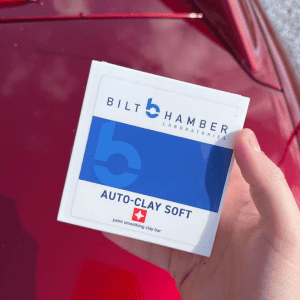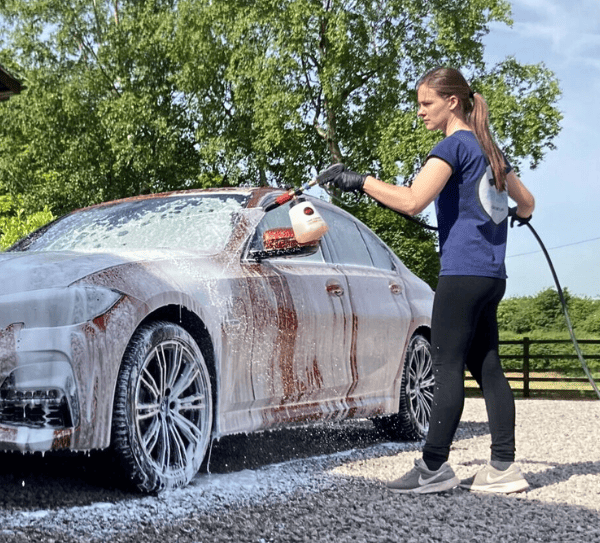Claying is an important part of the decontamination process on a car’s paintwork and glass as it removes bonded contaminants which cause the surface to feel rough.
There are two categories of clay media that you can choose from:
- Traditional clay bars
- Synthetic clay mitts, gloves, towels, blocks etc.
But what is the difference between these two types of clay? And which is the best option for your vehicle?
| Clay Bar | Clay Mitt |
| More abrasive so better at tackling heavier contamination but more likely to mar | Less abrasive so less likely to mar but also will struggle with heavier contamination |
| Small surface area – easier to manipulate around tighter areas | Larger surface area – makes the claying process faster |
| Thinner and harder so makes it easier to feel when the contaminants have been lifted | Thicker and more padded so makes it harder to feel when the surface is smooth |
| Cannot be reused and must be thrown away if dropped | Can be reused (up to 50x) by rinsing in water after claying each area |
| Easier to drop on the floor | Harder to drop on the floor |
| Cheaper but less cost-effective as fewer vehicles can be clayed | More expensive but more cost effective as it can clay many vehicles |
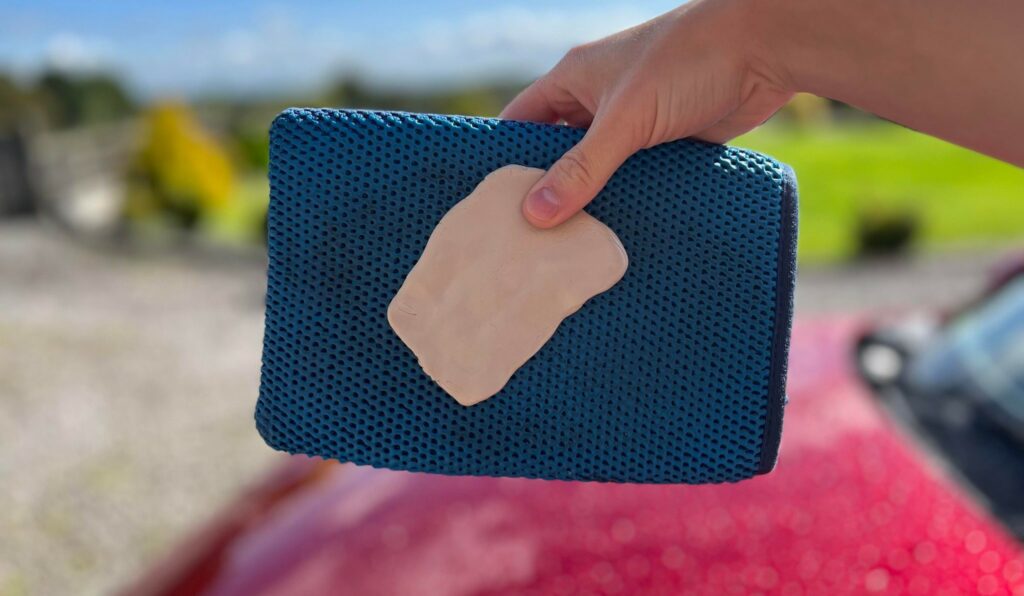
How to Use Them
The general claying process stays the same when using either a clay bar or clay mitt, in that you need to coat the clay media and the paintwork with a lubricant (check out this article for a list of the best lubricants) and then work in straight-line motions until the contaminants have been lifted and the surface feels smooth.
However, there are a few differences in how you use these types of clay and some considerations you need to make.
Clay bars:
- First a section of the clay must be cut from the bar. Usually this should be around 1/3 the size of a regular clay bar.
- The clay must then be warmed either in the hand or by running under warm water to soften it. The clay can then be kneaded and flattened into a disc shape.
- The clay should be folded regularly to expose a new side to avoid contaminants clogging the surface.
- Once the clay has been used, it should be disposed of.
Clay mitts:
- In order to soften the clay mitt, it should be first used on the glass before using it on the paintwork.
- After claying each section, the mitt should be rinsed in a clean bucket of water in order to release the collected contaminants.
- After use, the clay mitt should be left to dry and then stored in a sealed container.
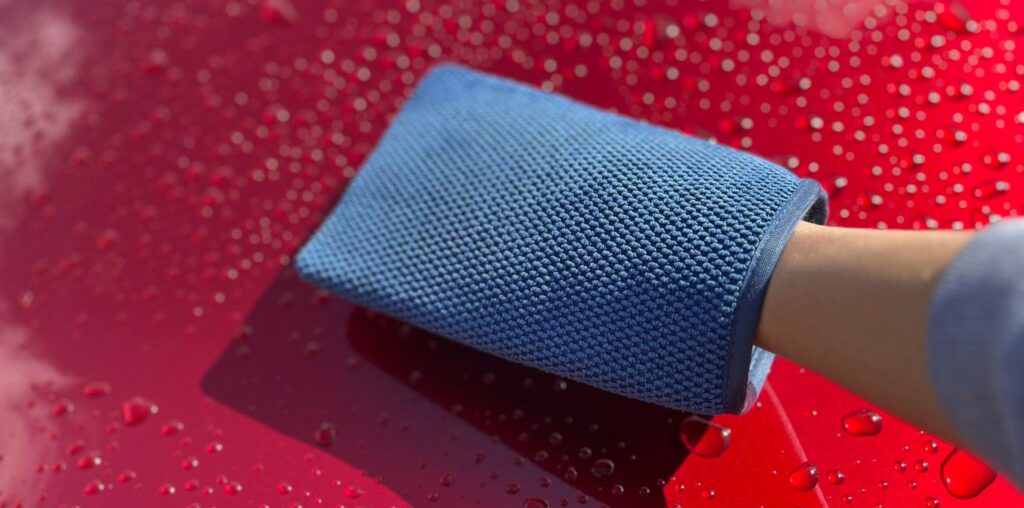
Abrasiveness
Traditional clay bars are more abrasive than clay mitts. This means two things:
- Clay bars are better are removing heavier contamination compared to clay mitts
- Clay bars are more likely to mar the paintwork compared to clay mitts
There are various grades of clay bars ranging from soft to medium to aggressive. However, even the “soft” grades are almost always more abrasive than clay mitts.
If you are claying a heavily contaminated vehicle, for example one which is stored outside, washed infrequently and hasn’t been clayed in over 2 years, you will likely need to use a clay bar. A clay mitt is unlikely to shift this type of contamination and will either simply glide over it, or take a really long time to remove it.
If on the other hand you are claying a car which is washed every couple of weeks and was clayed around 12 months ago, then a clay mitt is a better option. It will be abrasive enough to deal with the level of contamination that you’re likely to find on this type of vehicle and will cause less marring in the process.
On harder paints with minimal contamination, you may not notice any marring at all after using a clay mitt. This is unlikely to happen when using a traditional clay bar.
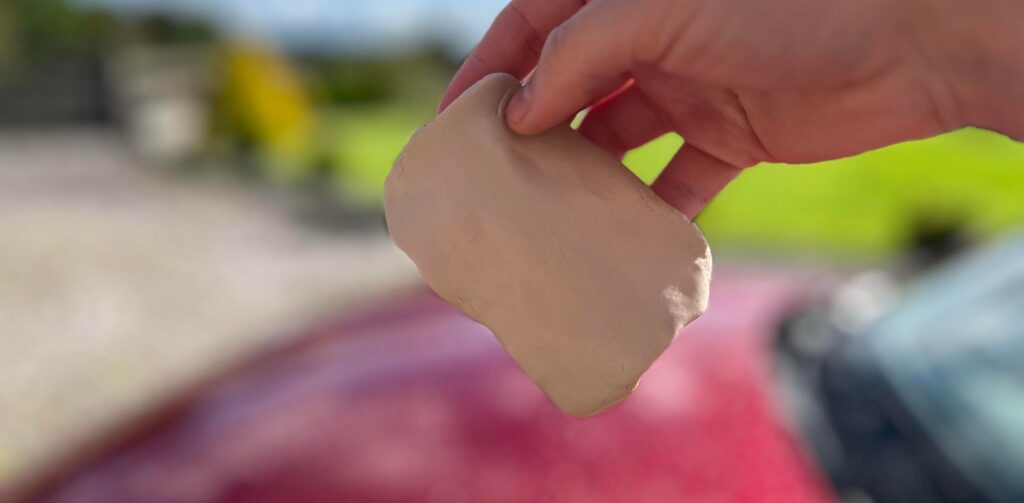
Surface Area
A significant benefit of a clay mitt is that it is much larger compared to a traditional clay bar.
When you flatten and press out a section of the clay bar, you’ll typically be working with a piece that’s around 8 x 8 cm (roughly 3 x 3″). Clay mitts on the other hand typically measure 20 x 14 cm (8.5 x 5.5″).
This means you can clay a whole vehicle much faster when using a clay mitt compared to using a clay bar. On average it takes me around half the time to clay a car using a clay mitt (roughly 15-20 minutes).
However, clay bars are much easier to manipulate around tighter areas, for example around the grille or headlights compared to clay mitts which are bulkier.
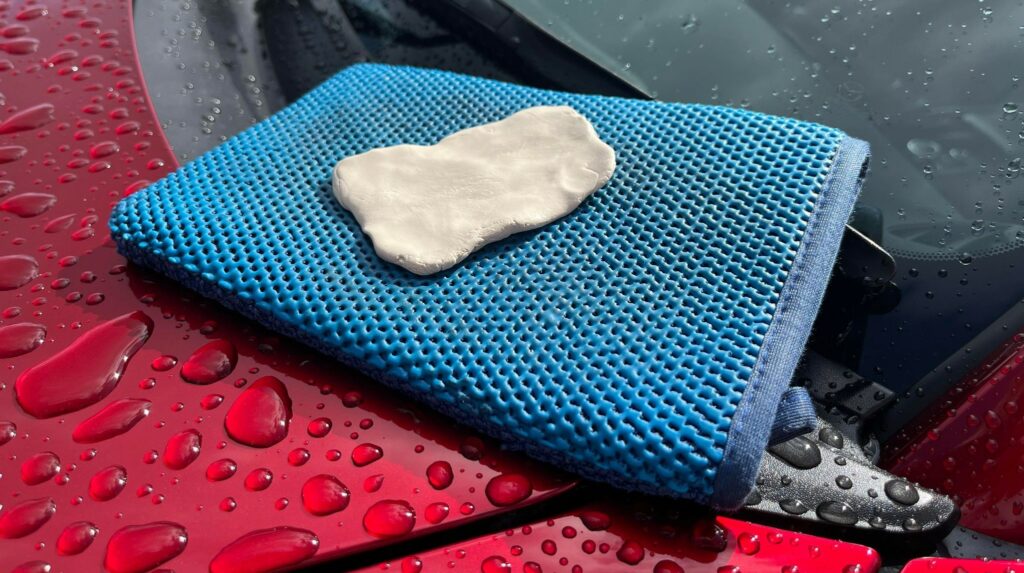
Feel and Feedback
Traditional clay bars offer a more tactile experience and better feedback compared to clay mitts. By this, I mean that it’s much easier to feel the contamination on the surface actually being lifted when using a clay bar, because it’s stiffer and thinner.
It’s much harder to feel the surface becoming smooth when using a clay mitt, because the mitt adds a lot of padding in between the hand and the paintwork.
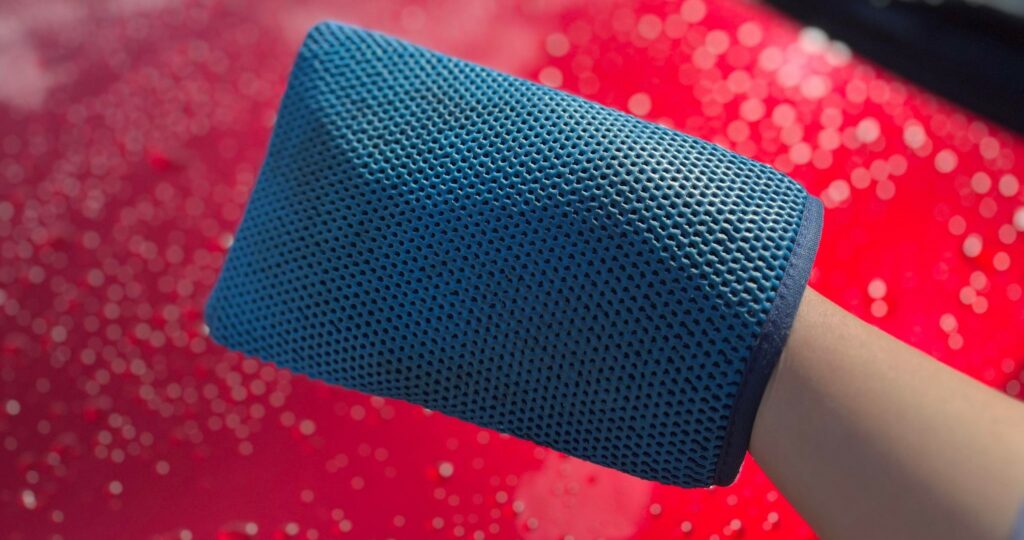
Reusability
One of the main benefits of a clay mitt over a clay bar, is that it can be reused many times.
Most synthetic clay mitts can be used up to 50 times before they should be disposed of, provided they are cared for properly. This is because the mitt can be rinsed in clean water and will released the contaminants it has collected so it can be used on the paintwork again.
Clay bars on the other hand will not release the contaminants when they are rinsed, and become essentially full of debris. It’s not safe to use the same piece of clay on another car as it will cause excessive marring due to the build up of all the contaminants in the clay.

Risk of Dropping
Clay bars are notoriously easy to drop, and if you do drop the piece on the floor it absolutely must be thrown away and not used on the paintwork. This is because it’s super sticky so will grab onto all the dirt and grit on the floor which will then get rubbed into the paintwork.
Since clay mitts and gloves actually go around your hand, they’re almost impossible to drop on the floor. Clay cloths and blocks are easier to drop in comparison to mitts/ gloves, but still less likely to get dropped than clay bars because they are larger and easier to grip onto.
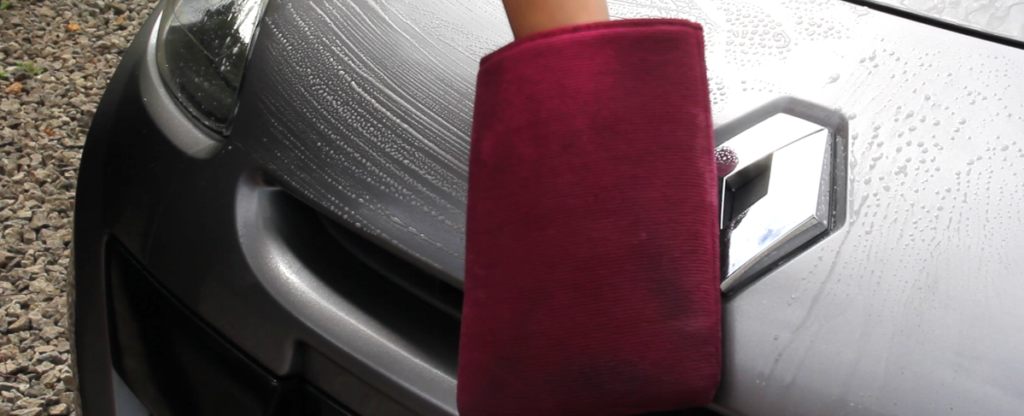
Cost and Value
Clay mitts are almost always more expensive than clay bars:
- Clay mitts on average cost £20/ $20
- Clay bars on average cost £10/ $10
However, when you consider how many times you can use each type of clay, using a clay mitt is by far the most cost-effective option.
Clay mitts typically can be used up to 50 times before they should be disposed of, however this does depend on the severity of the contamination they’re being used to tackle. Say you get even half of that durability, and use it on 25 cars, it still works out as only $0.80/£0.80 per use.
Most clay bars can be cut into sections to decontaminate around 3 average sized vehicles. This works out as about $3.33/£3.33 per vehicle, making it significantly more expensive compared to using a clay mitt.
Pros and Cons of Using a Clay Bar
Here are the advantages and disadvantages of traditional clay bars.
| Pros | Cons |
| Better at tackling heavier contamination | More aggressive – will cause more marring |
| Offers better feedback – easier to feel when the contaminants have been lifted | Must be thrown away if dropped and cannot be reused |
| Less expensive to purchase | Small surface area – takes more time to clay a car |
Pros and Cons of Using a Clay Mitt
Here are the advantages and disadvantages of using a synthetic clay mitt.
| Pros | Cons |
| Less abrasive and less likely to cause marring | Will struggle with heavy contamination |
| Larger surface area makes the claying process faster | Hard to feel when the contaminants have been lifted |
| Can be reused and works out more cost-effective | Expensive to purchase |
Best Clay Bars and Mitts
This section contains product affiliate links. We may receive a commission if you make a purchase after clicking on one of these links.
If you’re looking for recommendations, here are my favourite clay media options:
The Rag Company Ultra Clay Mitt
This clay mitt is a really good size so allows me to clay an entire vehicle very quickly. It also causes minimal marring and is really durable. Here are links to the product.
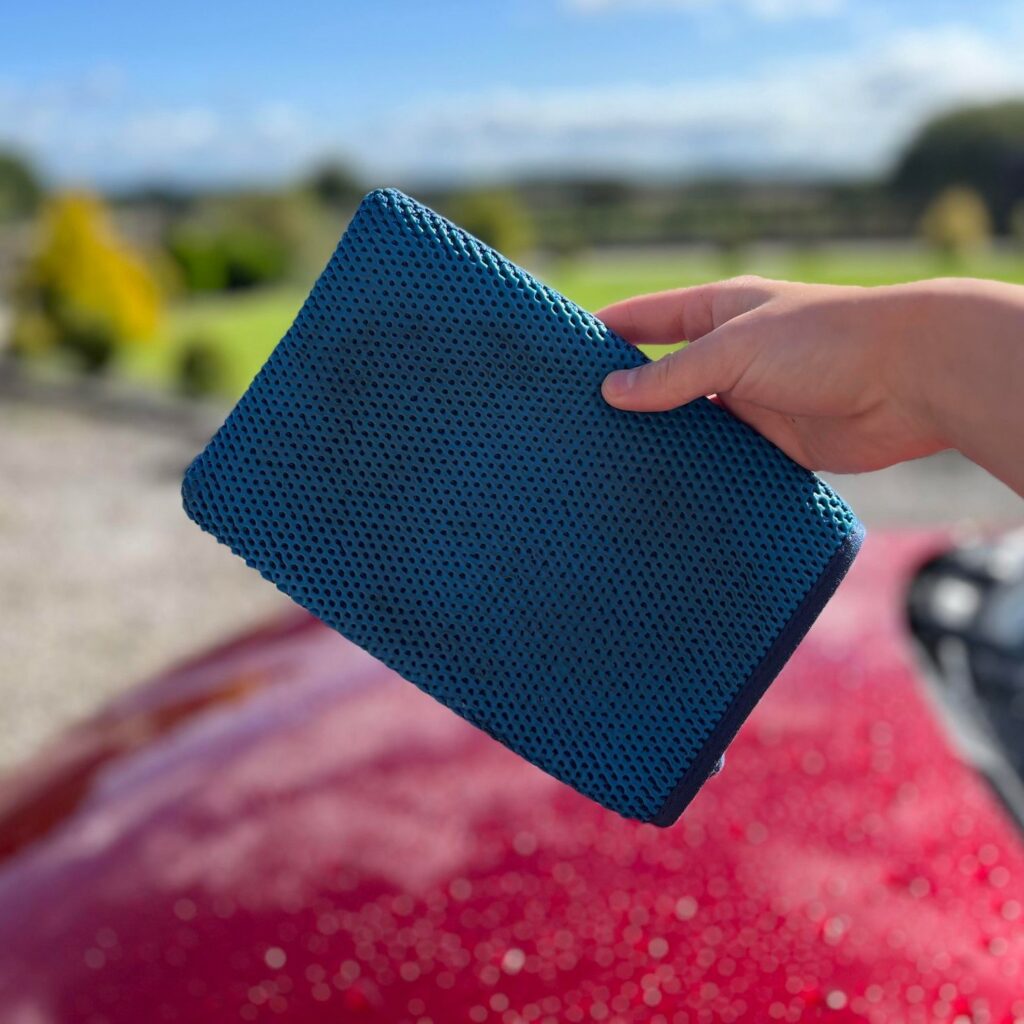
The Rag Company Ultra Clay Bar
If you’re looking for a bit of a step up in terms of abrasiveness but don’t want to go for a heavy type of clay, this is a very good option. Ideal for vehicles which are stored outdoors and driven frequently.
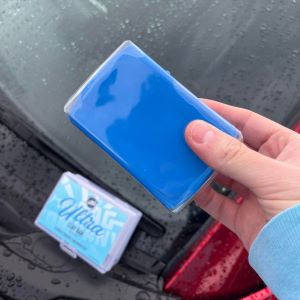
Bilt Hamber Soft Clay
Although it’s described as a “soft clay”, I find that it still easily tackles heavier contamination but without being overly abrasive. It’s also cost effective and comes in a plastic tub making it easy to store.
